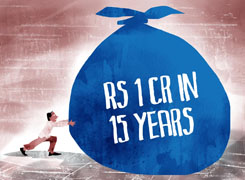Ramalingam Kalirajan |10874 Answers |Ask -Follow
Mutual Funds, Financial Planning Expert - Answered on Jul 03, 2025
He has an MBA in finance from the University of Madras and is a certified financial planner.
He is the director and chief financial planner at Holistic Investment, a Chennai-based firm that offers financial planning and wealth management advice.... more

I am 56 yrs old, recently got into semi retired mode earning about INR 1.5 Lacs pm. Have 2.4 CRs in Mutual Fund, 1 CR between PPF and FDs and another 75 Lacs as fixed return from LIC and other policies. Have no loans except for a possible 10 Lacs Education loan for my son who got into Engineering this year. My wife is working with an MNC. Pls share possible plan I need to make to have a retirement earning of INR 1.5 Lacs when I reach 60 yrs. Thanks Ranjan
Age: 56 years
Earning: Rs. 1.5 lakhs per month (semi-retired)
Mutual funds: Rs. 2.4 crores
PPF + FDs: Rs. 1 crore
LIC and other fixed policies: Rs. 75 lakhs
No loans yet. A Rs. 10 lakh education loan may be taken soon
Wife working in MNC (Income not included, but a support)
You are in a solid financial position already. You have Rs. 4.15 crores invested across different asset classes. You also have consistent income, good investment spread, and minimal liabilities.
Your goal is to generate Rs. 1.5 lakhs per month from age 60. That means, you want this income to be sustainable and reliable throughout retirement.
Let us plan this carefully with a full 360-degree view.
Assessing Retirement Income Need
You are 56. Retirement starts at 60.
Monthly income goal at retirement: Rs. 1.5 lakhs
Current lifestyle already set to this number
Adjusted for inflation, it would be higher at 60
If inflation is modest, target should be Rs. 2.25 lakhs per month at age 60
Retirement could last for 30 years or more
Your retirement corpus must support withdrawals till age 90+
We will now look at building a robust retirement income system for these 30 years.
Structure of Retirement Assets
Your assets are well spread out.
Rs. 2.4 crores in mutual funds
Rs. 1 crore in PPF and FDs
Rs. 75 lakhs in LIC and fixed policies
Let us evaluate each component and its role in the plan.
Mutual Fund Corpus Review
Rs. 2.4 crores in mutual funds is your strongest asset. It has flexibility and inflation-beating potential.
Mutual funds grow with time
They offer liquidity, better post-tax returns
They can be structured as monthly withdrawal tools
Active fund management adapts to market cycles
Index funds should be avoided
Index funds fall blindly in crashes
No downside control in index funds
Actively managed funds reduce volatility over long term
Keep this mutual fund corpus under a Certified Financial Planner
Use regular plans through a trusted MFD for expert fund selection
If any part of this corpus is in direct plans:
You lack handholding during volatility
Miss timely switches or fund exits
No behavioural support during crises
Regular plans offer advisory value worth more than saved expense ratio
You must review mutual fund selection every 6 months.
PPF and Fixed Deposit Role
You have Rs. 1 crore in PPF and FDs. This gives capital protection and stable returns.
PPF is tax-free and long-term
FDs are liquid but fully taxable
PPF matures in blocks of 15 years
Use PPF for late retirement years
Use FDs for short-term income support between age 60–63
Do not keep more than 3 years of expenses in FDs
Rest can be moved to conservative hybrid mutual funds
These funds should act as backup for equity years and contingency reserve.
LIC and Other Fixed Return Products
You have Rs. 75 lakhs in LIC and similar instruments.
These give fixed return
But often very low, around 4–5% net
If these are investment-linked policies like ULIPs or traditional plans
You must evaluate surrender now
If surrender value is attractive, move it into debt or hybrid mutual funds
If still locked, wait till maturity, then reinvest smartly
Don’t reinvest maturity in new LIC or endowment products
Do not buy annuities with this corpus
Annuities give low return, taxable income, and poor legacy value
Convert these assets into flexible, tax-efficient income sources post-maturity.
Approach Towards Education Loan
You may take a Rs. 10 lakh education loan.
This is manageable considering your asset base
Don’t redeem mutual funds for this
Let your son take the loan
Let him repay once he starts earning
You may support EMI from your monthly income
Keep retirement corpus untouched for this loan
Don’t pledge LIC or PPF for the loan security
Education loans come with tax benefits and delayed repayment options.
Wife’s Income as Safety Buffer
Your wife is working with an MNC.
Her income can support household for next few years
Avoid using her income for building retirement corpus
Instead, use her savings for second line of defence
She should also build her own retirement reserve
Both of you must have independent financial plans
If either one stops earning early, the plan should still work.
How to Structure Retirement Corpus
By age 60, your corpus may grow to Rs. 6 crores or more.
Break this into three buckets:
Bucket 1 – First 5 years (age 60–65)
Use FDs and conservative mutual funds
Also use part of hybrid mutual funds
Keep Rs. 1 crore in this bucket
Bucket 2 – Next 10 years (age 65–75)
Invest in balanced and large cap mutual funds
Start systematic withdrawals after 5 years
Keep around Rs. 2.5 crores here
Bucket 3 – Last 15 years (age 75–90)
Invest in growth mutual funds with high equity exposure
This grows during first 20 years
Use only after age 75
Keep Rs. 2.5 crores here
This 3-bucket system creates growth, safety, and tax efficiency together.
Monthly Withdrawal Strategy
From age 60:
Start SWP (Systematic Withdrawal Plan) from equity mutual funds
Keep 3–6 months expenses in liquid funds
Use monthly withdrawal from hybrid and large-cap funds
Adjust withdrawal amount every 2–3 years for inflation
Don’t withdraw from PPF or late-stage LIC corpus early
Let the long-term money grow untouched till 75
This helps the retirement corpus last longer.
Tax Management in Retirement
Keep taxation under control using these steps:
Withdraw from mutual funds in a staggered way
Equity fund LTCG above Rs. 1.25 lakh taxed at 12.5%
STCG taxed at 20%
Avoid withdrawing large amounts in one year
Plan SWP in such a way that you stay within tax exemptions
Don’t withdraw from FDs early to avoid penalty
PPF remains tax-free, best used after 75
Work with your Certified Financial Planner to optimise taxes every year.
Emergency Reserve in Retirement
Always keep 12 months’ expenses aside.
This is about Rs. 18 lakhs at retirement
Keep in ultra-short term debt funds or sweep-in FDs
Do not invest this in equity
This is not to be touched for investing or gifts
Maintain it through entire retirement phase
This gives confidence and safety during emergencies.
Health and Contingency Planning
Buy personal health insurance, if not already done
Don’t depend only on corporate policy
Add critical illness cover and personal accident cover
Maintain yearly health checkups
Create a medical buffer corpus of Rs. 10–15 lakhs separately
Don’t mix this with your retirement income
Health is the biggest retirement risk today. Plan ahead wisely.
Estate Planning Essentials
Prepare a Will now
Update nominee details in all your investments
Make your wife joint holder where needed
Share password and asset details with spouse
Include digital assets and bank lockers
Keep documents in a single place
Without estate planning, wealth transfer becomes complex. Start today.
Risk Protection for Retirement Years
Don’t invest in products that lock your money for long
Avoid capital guaranteed insurance products
Don’t go for annuity schemes
Avoid index funds which fall sharply with markets
Use actively managed funds with a CFP’s help
Avoid chasing very high returns
Capital protection is more important than maximising returns
Balance growth and safety properly for peace of mind.
Final Insights
You are on track for a financially safe retirement. Just a few steps ahead:
Continue mutual fund investment till 60
Don’t redeem unless truly required
Use a Certified Financial Planner to optimise your plan
Don’t shift to real estate or annuities
Keep focus on liquidity, tax, and flexibility
Create the 3-bucket retirement income model
Involve your wife in the plan
Keep insurance and estate documents updated
Prepare for health costs and emergencies
Your financial structure is strong. Just stay alert and aligned.
Best Regards,
K. Ramalingam, MBA, CFP,
Chief Financial Planner,
www.holisticinvestment.in
https://www.youtube.com/@HolisticInvestment
You may like to see similar questions and answers below
Ramalingam Kalirajan |10874 Answers |Ask -Follow
Mutual Funds, Financial Planning Expert - Answered on Jul 25, 2024
Ramalingam Kalirajan |10874 Answers |Ask -Follow
Mutual Funds, Financial Planning Expert - Answered on Aug 14, 2024
Ramalingam Kalirajan |10874 Answers |Ask -Follow
Mutual Funds, Financial Planning Expert - Answered on Aug 14, 2024
Ramalingam Kalirajan |10874 Answers |Ask -Follow
Mutual Funds, Financial Planning Expert - Answered on Sep 09, 2024
Ramalingam Kalirajan |10874 Answers |Ask -Follow
Mutual Funds, Financial Planning Expert - Answered on Jul 29, 2025
Mayank Chandel |2569 Answers |Ask -Follow
IIT-JEE, NEET-UG, SAT, CLAT, CA, CS Exam Expert - Answered on Dec 08, 2025
Mayank Chandel |2569 Answers |Ask -Follow
IIT-JEE, NEET-UG, SAT, CLAT, CA, CS Exam Expert - Answered on Dec 08, 2025

Mayank Chandel |2569 Answers |Ask -Follow
IIT-JEE, NEET-UG, SAT, CLAT, CA, CS Exam Expert - Answered on Dec 08, 2025
Mayank Chandel |2569 Answers |Ask -Follow
IIT-JEE, NEET-UG, SAT, CLAT, CA, CS Exam Expert - Answered on Dec 08, 2025
Mayank Chandel |2569 Answers |Ask -Follow
IIT-JEE, NEET-UG, SAT, CLAT, CA, CS Exam Expert - Answered on Dec 08, 2025
Anu Krishna |1746 Answers |Ask -Follow
Relationships Expert, Mind Coach - Answered on Dec 08, 2025
Ramalingam Kalirajan |10874 Answers |Ask -Follow
Mutual Funds, Financial Planning Expert - Answered on Dec 08, 2025
Samraat Jadhav |2499 Answers |Ask -Follow
Stock Market Expert - Answered on Dec 08, 2025
Ramalingam Kalirajan |10874 Answers |Ask -Follow
Mutual Funds, Financial Planning Expert - Answered on Dec 08, 2025
Radheshyam Zanwar |6737 Answers |Ask -Follow
MHT-CET, IIT-JEE, NEET-UG Expert - Answered on Dec 08, 2025





















